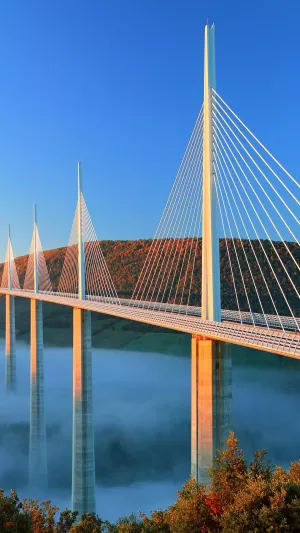Bridges are indispensable structures that facilitate seamless passage over rivers, lakes, and seas for both vehicles and pedestrians. They come in various forms, such as girder bridges, arch bridges, suspension bridges, and cable-stayed bridges.
This article focuses on the cable-stayed bridge, an engineering marvel that stands out for its unique design and structural efficiency.
A cable-stayed bridge, known simply as such, is characterized by a main girder directly supported by multiple cables affixed to bridge towers. This structural system comprises towers under compression, cables under tension, and beams under bending.
Essentially, it can be visualized as a multi-span elastically supported continuous beam with cables replacing traditional piers. This innovative design reduces the bending moment in the beam, lowers the structure's overall height, minimizes weight, and optimizes material usage. Key components of cable-stayed bridges include cable towers, girders, and stay cables.
The mechanical characteristics of cable-stayed bridges, coupled with the properties of the materials used, ensure that the center of gravity remains firmly on the cable towers, resulting in a stable and secure bridge within the designated load range.
Now, let's explore some of the most breathtaking cable-stayed bridges from around the world:
1. Tatara Bridge, Japan:
Nestled between Honshu Island and Shikoku Island, Tatara Bridge proudly stands as a testament to architectural ingenuity. With its imposing steel box girder as the primary structure, it claimed the prestigious title of the world's largest cable-stayed bridge upon its awe-inspiring completion. With a total length of 1480m and a main span of 890m, the bridge resembles a colossal blue dragon, connecting Hiroshima City in Honshu to Matsuyama City in Shikoku.
2. Millau Viaduct, France:
Often hailed as the world's first bridge, the Millau Viaduct in France is an architectural marvel spanning the Tarn Valley. Despite its impressive length of 2.46 kilometers, the bridge is supported by only seven piers. Notably, the No. 2 and No. 3 piers stand as the world's two tallest piers, reaching heights of 245 meters and 220 meters, respectively.
3. Normandy Bridge, France:
Designed by M. Virlogeux, the Normandy Bridge in France features a composite beam with a main span of 856 meters. Completed in 1995, this cable-stayed bridge seamlessly integrates with the local landscape, showcasing a slender structure and an elegant form. It earned the title of "The Most Beautiful Bridge in the World in the 20th Century" and serves as a crucial route for approximately 6,000 vehicles daily, contributing to the efficient travel across northern France.
4. Baruat Bridge:
Named after the Baruat River, this cable-stayed bridge stands as a testament to engineering ingenuity in navigating challenging terrains. The Baruat River, forming the border between Sinaloa and Durango in Mexico, cuts through treacherous terrain known as "The Devil's Backbone." The cable-stayed bridge facilitates direct access to this region, allowing construction teams to overcome the obstacles presented by the jagged peaks and unstable ridges of the Sierra Madre Occidental.
Cable-stayed bridges represent a pinnacle in bridge engineering, combining aesthetics with structural efficiency. As demonstrated by these remarkable examples, these bridges not only serve as vital transportation links but also stand as iconic symbols of human ingenuity and architectural prowess.





